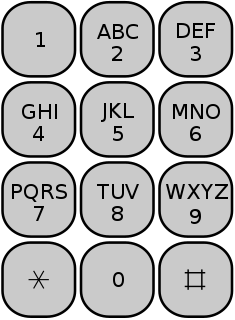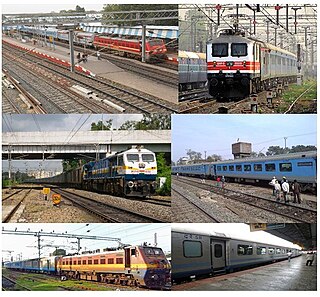
Rail transport is an important mode of transport in India.
Indian Railway Catering and Tourism Corporation (IRCTC) is a subsidiary of the Indian Railways that handles the catering, tourism and online ticketing operations of the Indian railways, with around 5,50,000 to 6,00,000Template:MOS:DIGITS bookings every day is the world's second busiest and highest of 15 to 16 lakh tickets every day. Its tagline is "Lifeline of the nation".

Namma Metro, also known as Bengaluru Metro is a rapid transit system serving the city of Bengaluru, India. As of February 2019 the fourth longest operational metro network in India after the Delhi Metro, Hyderabad Metro and Chennai Metro. An year back it was the second longest metro in the country. However snailpaced construction of Phase 2 has resulted in Chennai and Hyderabad occupying top slots and pushing Bangalore to fourth slot. On the other hand, Namma Metro was ranked the 83rd largest metro system in terms of length and the 79th largest metro network in terms of number of operating stations in the world. It also contains the first underground metro line in South India. The metro network consists of two colour-coded lines, with a total length of 42.3 kilometres serving 41 stations. The system has a mix of underground, at-grade, and elevated stations using standard-gauge tracks. The metro has an average daily ridership of 400,000 passengers. By 2023, the system is expected to complete its phase 2 network and provide connectivity to the city's important tech hubs of Electronics City and Whitefield.

The Chennai Metro is a rapid transit system serving the city of Chennai, Tamil Nadu, India. The system commenced service in 2015 after partially opening the first phase of the project. The network consists of two colour-coded lines covering a length of 45 kilometres (28 mi).
The Centre for Railway Information Systems (CRIS) designs, develops, implements and maintains most of the important information systems of Indian Railways. It is located in Chanakyapuri, New Delhi. CRIS was established by the India's Ministry of Railways in 1986.

Dinesh Trivedi is an Indian politician from the All India Trinamool Congress party, was Member of parliament, Lok Sabha in the Lower House representing Barrackpore, West Bengal. He is the former Union Minister for Railways and the former Union Minister of State for Health and Family Welfare.Trivedi was recipient of Outstanding Parliamentarian Award for 2016-2017 period and was felicitated at an event at the central hall of Parliament. He is also the Chairman of the Indo-European Union Parliamentary Forum (IEUPF), and other Parliamentary Forums.
The Secunderabad Junction railway station, is a major intercity railway station and a commuter rail hub in the Hyderabad urban area. In the city centre, the station is in the South Central Railway zone of Indian Railways. Built in 1874 by the Nizam of Hyderabad during the British era, it was the main station of Nizam's Guaranteed State Railway until the Kachiguda railway station opened in 1916. The station was taken over by Indian Railways in 1951, when NGSR was nationalized. Its main portico and concourse are influenced by Nizamesque architecture. The station, which resembles a fort, is a tourist attraction in the twin cities of Hyderabad and Secunderabad.
India does not have any railways that can be classified as high-speed rail (HSR) by international standards, i.e. railways with operational speeds exceeding 200 km/h (120 mph). The current fastest train in India is the Train 18 with a top speed of 180 km/h (110 mph), which runs between New Delhi and Varanasi.
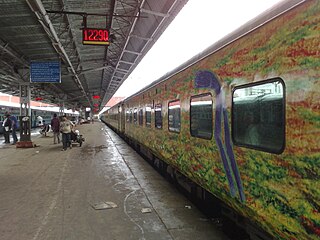
Duronto Express is a category of long-distance non stop source to destination trains run by the Indian Railways. Initially these trains did not have any ticketing stops between the origin and the destination, but since January 2016 it is possible to book tickets from those technical stops. "Duronto" means "restless" in Bangla. These trains' coaches have characteristic yellow-green livery. Duronto Express services connect the several metros and major state capitals of India.
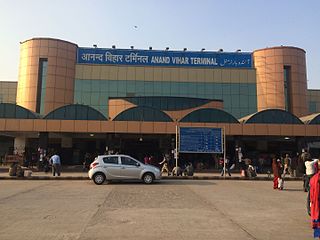
Anand Vihar Terminal, station code ANVT, is a railway station in the Anand Vihar locality of Delhi, India. It is under the administrative control of the Delhi Division of the Northern Railway zone of the Indian Railways.

Panvel is a railway station on the Harbour Line and Central zone of the Mumbai Suburban Railway network.

Kollam Junction railway station is a junction station situated in the city of Kollam in Kerala, India. It is the second largest railway station in Kerala in terms of area and is one of the oldest railway stations in the state. World's second longest railway platform is situated at Kollam railway station.
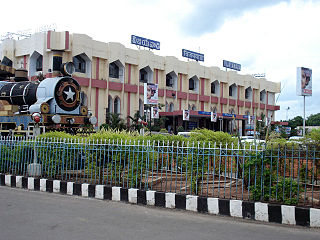
Vijayawada railway division is one of the four railway divisions under South Coast Railway zone of the Indian Railways. The headquarters of the division are located at Vijayawada.
The Suvidha Express also called as Premium Express series of trains were introduced by Indian Railways in 2014 for the 1st time which is operated in busiest routes.. They were intended to follow dynamic pricing in fares similar to that of airlines contrary to the standard one fare for one class of travel generally followed by Indian Railways. Priority of Premium trains are above Superfast and Mail/Express trains like Shatabdi Express, Duronto Express and Rajdhani Express.
The Khurda Road–Bolangir line is a rail line between Khurda Road Junction and Balangir which is under construction.
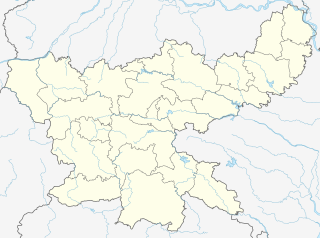
Hazaribagh Town railway station belongs to East Central Railway of Dhanbad division. It is located on NH100 Kumhar Toli Hazaribagh district of Jharkhand state.

2014 Railway Budget of India refers to the Railway Budget of the Indian Railways in the fiscal year 2014–15. The budget was presented in the India Parliament by Railway Minister D. V. Sadananda Gowda on 8 July 2014.
The Indian government is undertaking several initiatives as to upgrading its aged railway infrastructure and enhance its quality of service. The Railway Ministry has announced plans to invest ₹905,000 crore (US$126 billion) to upgrade the railways by 2020. IR's Research Design and Standards Organisation (RDSO) undertakes all research, designs and standardisation work for modernisation.

2016 Railway Budget of India refers to the Railway Budget of the Indian Railways in the fiscal year 2016–17. The budget was presented by the Railway Minister Suresh Prabhu in the Parliament on 25 February 2016. It was the final Railway Budget of India as after this budget, the Railway Budget got merged with the Union Budget of India.




